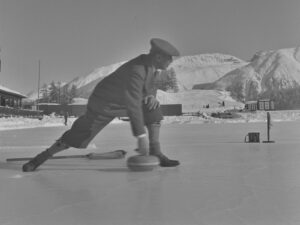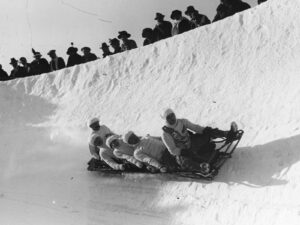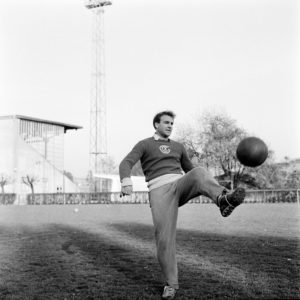
Swiss national museum /ASL
When ‘Uli the Tenant’ played for Grasshopper Club Zurich…
Football is more than just a sport. Football is culture, entertainment and even politics. As, for example, when Uli the Tenant played for Grasshopper Club Zurich. Or when carrots were grown in FC Baden’s stadium.
As an actor, Hannes Schmidhauser was the talk of the town. The film adaptations of Jeremias Gotthelf’s ‘Uli the Farmhand’ and ‘Uli the Tenant’ were among the most successful Swiss movies of all time. But Schmidhauser was just as talented as a footballer. He actually funded his acting training by playing sport. In Ticino, he played for FC Locarno and FC Lugano. The defender then moved to Grasshopper Club Zurich, with whom he won the double in 1956, taking home the Championship and the Cup. Meanwhile, he continued to appear in theatres nationwide, and it was not uncommon for him to have football training and a stage performance on the same day. He became a key player in the national team too, even captaining the team. One of Switzerland’s first stars, Schmidhauser coped very well with this unusual dual burden. It was only when he made an error on the field that he would often hear the audience chanting: ‘Uli, bisch wieder bim Vreneli gsy?’, a reference to his earlier film roles.
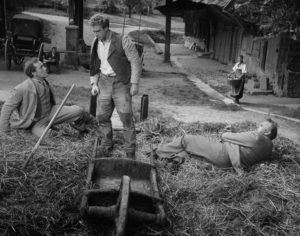
Filming of ‘Uli the Tenant’, 1955.
ETH Bibliothek, Image Archive
The big reconciliation scene between Uli and Vreneli from ‘Uli the Farmhand’.
YouTube
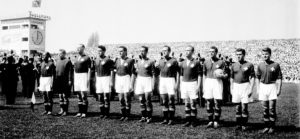
The Swiss national team lines up before the international match against Austria in Bern on May 2nd, 1955. Hannes Schmidhauser holds the ball.
Swiss national museum
More than just a piece of cloth
FC Chiasso can’t really boast of having legions of fans. At home games, it’s often only a handful of diehard followers that turn up. And perhaps the Ticino players’ most faithful supporter is not a human at all, but a piece of cloth. Whether at home or abroad, in Europe, Africa or America or in the farthest-flung corners of the planet, for the past three decades the indestructible flag, the ‘Drappo Rossoblù’, has been proclaiming a simple but powerful message: ‘Forza Chiasso!’ More than 30 years ago, the owner wrested the flag back from Lugano away fans, and since then it has passed through the hands of numerous travel-loving and adventurous Chiassesi. They carry the red-and-blue scrap of cloth all over the globe – to Mallorca, Kathmandu, the Sahara – and document Chiasso’s global presence in photographs. And the banner is a fixture at all the Swiss national team’s games. This very widely travelled flag experienced the most emotional moment in its homeland. In summer 2014, Ferdinando Riva, known as Riva IV, died. At the funeral of Chiasso’s all-time greatest player (left wing with almost 500 appearances between 1950 and 1970, and World Cup player in 1954), the piece of cloth was proudly in attendance.

The flag of FC Chiasso has circumnavigated the globe more than once. Seen here in a photo from China.
FC Basel in race fever
Liverpool FC ahead of Tottenham Hotspur and FC Basel: back in 2009, what reads like a Champions League group table was in fact the final rankings of the crazy ‘Superleague Formula’ format. Resourceful marketing people thought they had stumbled across the egg of Columbus. The idea: combine two of the most popular spectator sports, Formula 1 and football. ‘The Beautiful Race: Football at 300 km/h’ was the slogan of these races, held all over the world, in which top clubs such as AC Milan, Glasgow Rangers and Corinthians from Brazil competed against one another in 750-horsepower supercars. Unfortunately, the ‘symbiosis of the passion of football with the thrill of motor racing’ promised by the organisers met with a very poor response. By the fourth year of the competition, only a handful of football clubs were still involved; the season was cancelled after just two races and the ‘Superleague Formula’ was quietly buried. And so, with two 3rd-place spots in the rankings, FC Basel can boast of being among the all-time greats in a pointless competition.
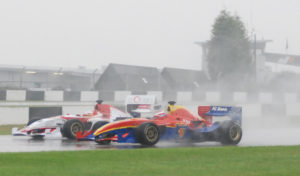
Superleague Formula race in England, 2008.
Wikimedia
Carrots instead of goals
Switzerland survived the First World War relatively unscathed, and that’s thanks in no small part to little FC Baden. At that time, the club was playing in Serie A, the highest league. But then Bosnian-Serb anarchist Gavrilo Princip murdered the heir to the throne of Austria-Hungary, Franz Ferdinand, unleashing displays of military strength worldwide. The turmoil of the war years forced Switzerland to give some thought to supplying food for its population. It was concluded that the country urgently needed to plant more crops. The playing field of FC Baden in the ‘Rüebliland’ – carrot country – was considered particularly suitable for this purpose. And so, from 1917 the Baden footballers had to spend a season sowing and harvesting instead of passing the ball and scoring goals. At the same time, FC Lucerne won the Serie B competition and needed an opposition team for its promotion match – and the Swiss Football Association forced the Baden club, by now completely out of practice, to step up. The Aargau players went down 0-7 to Lucerne and were relegated. It was the beginning of the club’s long drought; nearly seven decades would pass before FC Baden managed another brief guest appearance in the top league. And all because of a few carrots.
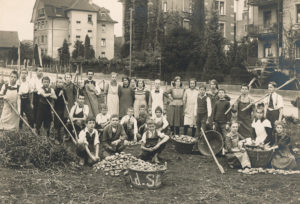
During the First World War, vegetables were grown all over the place in Switzerland. In schools, public parks and… on football pitches.
Swiss National Museum
When the promoted team becomes champion
There are many reasons for clubs to celebrate the end of the season. Some are looking forward to promotion; others are celebrating winning the championship title. In what is probably a unique world first, Lausanne Sports was able to do both simultaneously in 1932. And here’s how it happened: while grumbles of displeasure about how the league is organised are still a regular feature of football, in the early years of the Swiss championship this tendency was even more pronounced. As a result, the format was continually being changed, with no one system really proving better than any other. But the 1931/32 season took the biscuit. In two groups, the 18 first division clubs played a qualifying round, with the leaders qualifying for the final round. The runners-up in each group then played off against the third-placed finalists. And because 3 is such an unlovely number for a final tournament, the organisers hit upon the glorious idea of inviting Lausanne Sport, as the winner of the 2nd Division (!), to join in. The Vaud team leapt at the chance offered by this hare-brained gesture, swept aside FC Zurich, Grasshoppers and Urania Genève, and became both promoted team and champions in the same year.
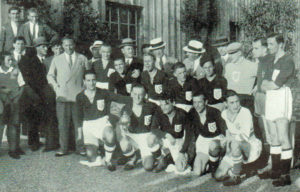
Would you believe it! Promoted team Lausanne became champions in 1932, without playing a single game in the top division.


